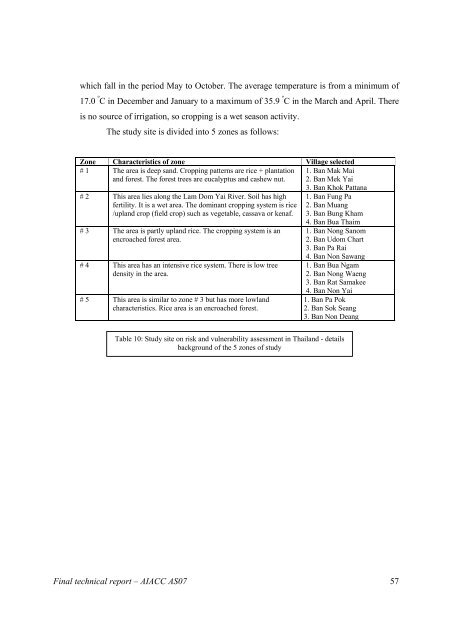Final Technical Report - weADAPT
Final Technical Report - weADAPT
Final Technical Report - weADAPT
- No tags were found...
Create successful ePaper yourself
Turn your PDF publications into a flip-book with our unique Google optimized e-Paper software.
which fall in the period May to October. The average temperature is from a minimum of<br />
17.0 º C in December and January to a maximum of 35.9 º C in the March and April. There<br />
is no source of irrigation, so cropping is a wet season activity.<br />
The study site is divided into 5 zones as follows:<br />
Zone Characteristics of zone Village selected<br />
# 1 The area is deep sand. Cropping patterns are rice + plantation 1. Ban Mak Mai<br />
and forest. The forest trees are eucalyptus and cashew nut. 2. Ban Mek Yai<br />
# 2 This area lies along the Lam Dom Yai River. Soil has high<br />
fertility. It is a wet area. The dominant cropping system is rice<br />
/upland crop (field crop) such as vegetable, cassava or kenaf.<br />
# 3 The area is partly upland rice. The cropping system is an<br />
encroached forest area.<br />
# 4 This area has an intensive rice system. There is low tree<br />
density in the area.<br />
# 5 This area is similar to zone # 3 but has more lowland<br />
characteristics. Rice area is an encroached forest.<br />
3. Ban Khok Pattana<br />
1. Ban Fung Pa<br />
2. Ban Muang<br />
3. Ban Bung Kham<br />
4. Ban Bua Thaim<br />
1. Ban Nong Sanom<br />
2. Ban Udom Chart<br />
3. Ban Pa Rai<br />
4. Ban Non Sawang<br />
1. Ban Bua Ngam<br />
2. Ban Nong Waeng<br />
3. Ban Rat Samakee<br />
4. Ban Non Yai<br />
1. Ban Pa Pok<br />
2. Ban Sok Seang<br />
3. Ban Non Deang<br />
Table 10: Study site on risk and vulnerability assessment in Thailand - details<br />
background of the 5 zones of study<br />
<strong>Final</strong> technical report – AIACC AS07 57
















